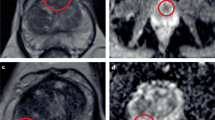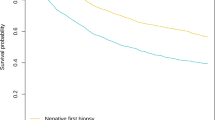Abstract
The natural history of prostate cancer is often of long duration, and the disease is incompletely understood. Whether all men with prostate cancer require immediate treatment or whether men with tumors of low malignant potential are being overtreated with potentially harmful therapies is a subject of much debate. Results from a randomized trial that compared watchful waiting and active therapy showed all-cause and disease-specific survival advantages with radical therapy, but the study group was mixed in terms of disease risk; the optimum treatment strategy for men with low risk features remains unclear. Multiple centers are gaining experience with active surveillance and delayed intervention with curative intent for men with prostate tumors of potentially low clinical risk. This Review describes the background studies behind the rationale for active surveillance, thoughts on selection criteria for candidates and some early reported outcomes for active surveillance cohorts. The psychosocial impact of active surveillance on patients is discussed as well as contemporary methods for disease monitoring.
Key Points
-
Active surveillance is a viable option for all men with low risk prostate cancer
-
Ideal candidates have features of low-risk disease on the basis of a well-performed prostate needle biopsy
-
Men must be followed up carefully with a well-planned strategy for PSA measurement, physical examination, and repeat prostate needle biopsy
-
Patient anxiety must be addressed and is a powerful driver of active treatment
-
Ongoing clinical trials will soon provide data on the optimum selection criteria and surveillance methods
This is a preview of subscription content, access via your institution
Access options
Subscribe to this journal
Receive 12 print issues and online access
$209.00 per year
only $17.42 per issue
Buy this article
- Purchase on Springer Link
- Instant access to full article PDF
Prices may be subject to local taxes which are calculated during checkout
Similar content being viewed by others
References
Jemal A et al. (2007) Cancer statistics, 2007. CA Cancer J Clin 57: 43–66
Johansson JE et al. (2004) Natural history of early, localized prostate cancer. JAMA 291: 2713–2719
Albertsen PC et al. (2005) 20-year outcomes following conservative management of clinically localized prostate cancer. JAMA 293: 2095–2101
Yatani R et al. (1982) Geographic pathology of latent prostatic carcinoma. Int J Cancer 29: 611–616
Draisma G et al. (2003) Lead times and overdetection due to prostate-specific antigen screening: estimates from the European Randomized Study of Screening for Prostate Cancer. J Natl Cancer Inst 95: 868–878
Etzioni R et al. (2002) Overdiagnosis due to prostate-specific antigen screening: lessons from U.S. prostate cancer incidence trends. J Natl Cancer Inst 94: 981–990
Breslow N et al. (1977) Latent carcinoma of prostate at autopsy in seven areas. The International Agency for Research on Cancer, Lyons, France. Int J Cancer 20: 680–688
Byar DP and Mostofi FK (1969) Cancer of the prostate in men less than 50 years old: an analysis of 51 cases. J Urol 102: 726–733
Guileyardo JM et al. (1980) Prevalence of latent prostate carcinoma in two U.S. populations. J Natl Cancer Inst 65: 311–316
Rullis I et al. (1975) Incidence of prostatic carcinoma in the elderly. Urology 6: 295–297
Wei JT et al. (2002) Comprehensive comparison of health-related quality of life after contemporary therapies for localized prostate cancer. J Clin Oncol 20: 557–566
Litwin MS et al. (2007) Quality of life after surgery, external beam irradiation, or brachytherapy for early-stage prostate cancer. Cancer 109: 2239–2247
Epstein JI et al. (1994) Pathologic and clinical findings to predict tumor extent of nonpalpable (stage T1c) prostate cancer. JAMA 271: 368–374
Greene KL et al. (2006) Prostate biopsy tumor extent but not location predicts recurrence after radical prostatectomy: results from CaPSURE. J Urol 175: 125–129
Roemeling S et al. (2006) Management and survival of screen-detected prostate cancer patients who might have been suitable for active surveillance. Eur Urol 50: 475–482
Carter HB et al. (2002) Expectant management of nonpalpable prostate cancer with curative intent: preliminary results. J Urol 167: 1231–1234
Venkitaraman R et al. (2008) Prostate-specific antigen velocity in untreated, localized prostate cancer. BJU Int 101: 161–164
Klotz L (2006) Active surveillance with selective delayed intervention for favorable risk prostate cancer. Urol Oncol 24: 46–50
Emiliozzi P et al. (2004) Increased accuracy of biopsy Gleason score obtained by extended needle biopsy. J Urol 172: 2224–2226
Vashi AR et al. (1998) A model for the number of cores per prostate biopsy based on patient age and prostate gland volume. J Urol 159: 920–924
Epstein JI et al. (1997) Use of repeat sextant and transition zone biopsies for assessing extent of prostate cancer. J Urol 158: 1886–1890
Partin AW et al. (2001) Contemporary update of prostate cancer staging nomograms (Partin Tables) for the new millennium. Urology 58: 843–848
D'Amico AV et al. (1998) Biochemical outcome after radical prostatectomy, external beam radiation therapy, or interstitial radiation therapy for clinically localized prostate cancer. JAMA 280: 969–974
Kattan MW et al. (1998) A preoperative nomogram for disease recurrence following radical prostatectomy for prostate cancer. J Natl Cancer Inst 90: 766–771
Cooperberg MR et al. (2005) The University of California, San Francisco Cancer of the Prostate Risk Assessment score: a straightforward and reliable preoperative predictor of disease recurrence after radical prostatectomy. J Urol 173: 1938–1942
Steyerberg EW et al. (2007) Prediction of indolent prostate cancer: validation and updating of a prognostic nomogram. J Urol 177: 107–112
Kattan MW et al. (2003) Counseling men with prostate cancer: a nomogram for predicting the presence of small, moderately differentiated, confined tumors. J Urol 170: 1792–1797
Roemeling S et al. (2007) Nomogram use for the prediction of indolent prostate cancer: impact on screen-detected populations. Cancer 110: 2218–2221
Wilt TJ and Brawer MK (1997) The Prostate Cancer Intervention Versus Observation Trial (PIVOT). Oncology (Williston Park) 11: 1133–1139
D'Amico AV et al. (2004) Preoperative PSA velocity and the risk of death from prostate cancer after radical prostatectomy. N Engl J Med 351: 125–135
D'Amico AV et al. (2005) Pretreatment PSA velocity and risk of death from prostate cancer following external beam radiation therapy. JAMA 294: 440–447
Freedland SJ et al. (2005) Risk of prostate cancer-specific mortality following biochemical recurrence after radical prostatectomy. JAMA 294: 433–439
Carter CA et al. (2003) Temporarily deferred therapy (watchful waiting) for men younger than 70 years and with low-risk localized prostate cancer in the prostate-specific antigen era. J Clin Oncol 21: 4001–4008
Ali K et al. (2007) PSA doubling time predicts the outcome after active surveillance in screening-detected prostate cancer: results from the European randomized study of screening for prostate cancer, Sweden section. Int J Cancer 120: 170–174
Stephenson AJ et al. (2002) Utility of PSA doubling time in follow-up of untreated patients with localized prostate cancer. Urology 59: 652–656
Epstein JI et al. (2001) Dedifferentiation of prostate cancer grade with time in men followed expectantly for stage T1c disease. J Urol 166: 1688–1691
Patel MI et al. (2004) An analysis of men with clinically localized prostate cancer who deferred definitive therapy. J Urol 171: 1520–1524
Carter HB et al. (2007) Expectant management of prostate cancer with curative intent: an update of the Johns Hopkins experience. J Urol 178: 2359–2364
Coakley FV et al. (2003) Magnetic resonance imaging and spectroscopic imaging of prostate cancer. J Urol 170: S69–75
Shukla-Dave A et al. (2007) The utility of magnetic resonance imaging and spectroscopy for predicting insignificant prostate cancer: an initial analysis. BJU Int 99: 786–793
Loch T (2007) Urologic imaging for localized prostate cancer in 2007. World J Urol 25: 121–129
Meng MV et al. (2003) Predictors of treatment after initial surveillance in men with prostate cancer: results from CaPSURE. J Urol 170: 2279–2283
Roemeling S et al. (2006) Active surveillance for prostate cancers detected in three subsequent rounds of a screening trial: characteristics, PSA doubling times, and outcome. Eur Urol 51: 1244–1250
Hardie C et al. (2005) Early outcomes of active surveillance for localized prostate cancer. BJU Int 95: 956–960
Klotz L (2005) Active surveillance with selective delayed intervention is the way to manage 'good-risk' prostate cancer. Nat Clin Pract Urol 2: 136–142
Martin RM et al. (2006) Continuing controversy over monitoring men with localized prostate cancer: a systematic review of programs in the prostate specific antigen era. J Urol 176: 439–449
Latini DM et al. (2007) The relationship between anxiety and time to treatment for patients with prostate cancer on surveillance. J Urol 178: 826–831
Wallace M (2003) Uncertainty and quality of life of older men who undergo watchful waiting for prostate cancer. Oncol Nurs Forum 30: 303–309
Bailey DE et al. (2004) Uncertainty intervention for watchful waiting in prostate cancer. Cancer Nurs 27: 339–346
Ornish D et al. (2005) Intensive lifestyle changes may affect the progression of prostate cancer. J Urol 174: 1065–1069
Author information
Authors and Affiliations
Corresponding author
Ethics declarations
Competing interests
The authors declare no competing financial interests.
Rights and permissions
About this article
Cite this article
Dall'Era, M., Konety, B. Active surveillance for low-risk prostate cancer: selection of patients and predictors of progression. Nat Rev Urol 5, 277–283 (2008). https://doi.org/10.1038/ncpuro1058
Received:
Accepted:
Published:
Issue Date:
DOI: https://doi.org/10.1038/ncpuro1058
This article is cited by
-
Active surveillance: Does serial prostate biopsy increase histological inflammation?
Prostate Cancer and Prostatic Diseases (2013)
-
Algorithms, nomograms and the detection of indolent prostate cancer
World Journal of Urology (2008)



